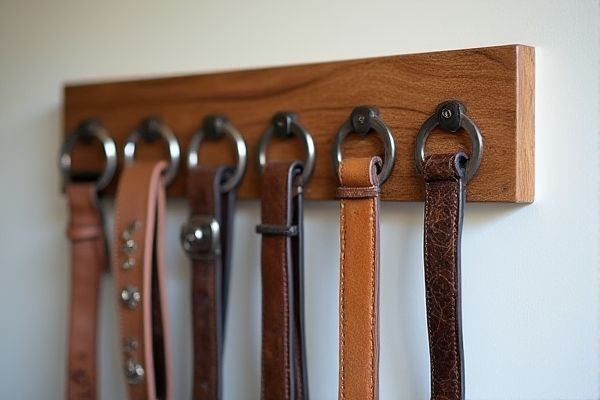
Belt racks provide organized, space-saving storage with easy visibility and access, while hook storage offers versatility and can accommodate various items beyond belts. Discover which option best suits your needs and optimizes your space by reading the rest of the article.
Table of Comparison
| Feature | Belt Rack | Hook Storage |
|---|---|---|
| Purpose | Organizes belts neatly, prevents creasing | Hangs belts or accessories, easy access |
| Space Efficiency | Compact, fits inside drawers or closets | Utilizes vertical wall or door space |
| Capacity | Holds multiple belts securely | Varies, typically fewer belts than racks |
| Material | Metal, wood, plastic options available | Metal hooks, adhesive or mounted |
| Installation | Freestanding or wall-mounted | Wall-mounted or adhesive hooks |
| Accessibility | Belt visibility and quick selection | Easy grab, less organized |
| Best Use | Dedicated belt organization | Multifunctional hanging for belts and accessories |
Introduction to Belt Rack and Hook Storage
Belt racks and hook storage systems offer organized solutions for keeping accessories neatly arranged, with belt racks specifically designed to maintain belts' shape and prevent tangling. Hook storage provides versatile hanging options suitable for various items beyond belts, such as bags or scarves, maximizing space efficiency. Choosing the right storage depends on your preference for accessibility and the types of accessories you need to store.
Key Differences Between Belt Racks and Hooks
Belt racks provide organized, space-saving storage by neatly displaying multiple belts side-by-side, which helps preserve their shape and makes selection easy. Hook storage offers a versatile, accessible option ideal for quick retrieval but may cause belts to twist or crease over time. Your choice depends on whether you prioritize efficient display and maintenance (belt racks) or simple, flexible access (hooks).
Design and Material Comparison
Belt racks typically feature a horizontal bar design made from durable metals like stainless steel or polished aluminum, providing sturdy support and preventing belt deformation. Hook storage systems often utilize strong plastic or wood with multiple hooks to hang belts individually, allowing easy access but potentially causing shape distortion if hung improperly. Both designs prioritize functionality, but metal belt racks offer enhanced durability and a sleek appearance, while hook storage emphasizes versatility and space-saving advantages.
Space Efficiency: Belt Rack vs Hook
Belt racks maximize space efficiency by allowing belts to be stored vertically and organized neatly, reducing clutter while making each item easily accessible. Hooks can save space by utilizing wall or door surfaces but may lead to overlapping or tangled belts, which diminishes organization and usability. Choosing a belt rack often results in better space management and improved visibility compared to hook storage solutions.
Installation and Setup Guide
Belt racks typically require wall mounting with screws and anchors, ensuring sturdy support for multiple items and often include adjustable shelves or rods for customization. Hook storage systems usually involve simpler installation, often just attaching hooks to a wall or a door, allowing for flexible positioning but less capacity for organized display. Both methods demand proper placement at accessible heights to maximize ease of use and efficient space management.
Accessibility and Convenience Factors
Belt racks offer organized visibility and easy access by displaying belts flat or rolled, reducing time spent searching for the right one. Hook storage maximizes space efficiency and allows quick hanging or removal, especially in tight closets or limited storage areas. Choosing between the two depends on your preference for either orderly presentation or compact accessibility in daily use.
Organization and Belt Protection
Belt racks offer structured organization by keeping belts neatly aligned, preventing tangling and preserving their shape for long-lasting wear. Hook storage can lead to overlapping or bending, which risks creasing and damaging leather or fabric belts over time. Your choice impacts both the ease of selecting belts and their durability, with racks providing superior protection and tidiness.
Aesthetic Appeal in Closet Design
Belt racks offer a sleek, organized appearance with uniform spacing that enhances closet aesthetics by keeping belts visible and easily accessible. Hook storage provides a more casual, adaptable display that can accommodate varying belt sizes and styles but may appear less structured. Choosing between these options depends on whether a clean, minimalist look or a flexible, eclectic design better suits the overall closet decor.
Cost and Value Assessment
Belt racks generally offer higher initial costs compared to hook storage due to their specialized design and materials, but they provide greater value by preventing belt deformation and simplifying organization. Hook storage tends to be more affordable and flexible, though it may cause belts to lose shape and require more frequent replacement, increasing long-term expenses. Choosing belt racks or hooks depends largely on balancing upfront investment against durability and maintenance costs for optimal wardrobe management.
Choosing the Right Storage for Your Belts
Choosing between a belt rack and hook storage depends on your space and organization needs; belt racks offer a sleek, compact design ideal for multiple belts, while hook storage allows easy access and flexibility for varying belt sizes. Your decision should consider ease of use, visibility, and how often you rotate your belts. Opting for the right solution ensures your belts stay wrinkle-free and readily accessible.
 homyna.com
homyna.com